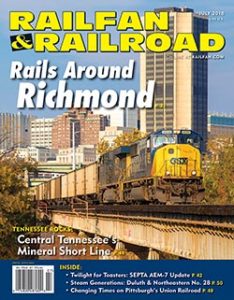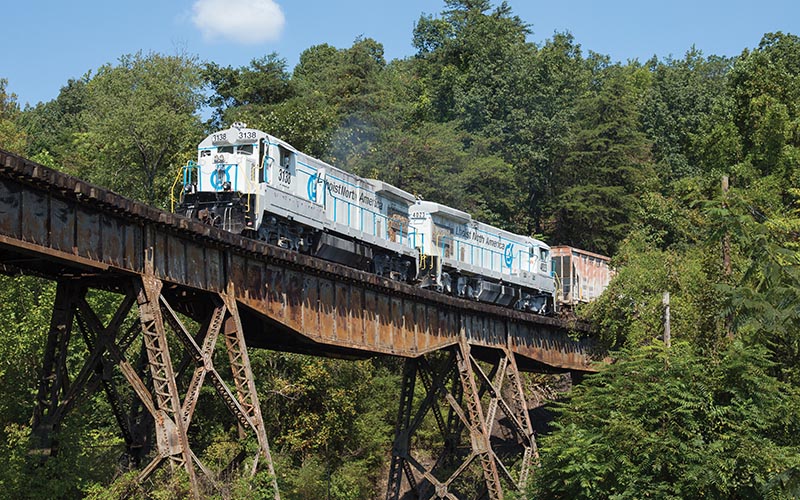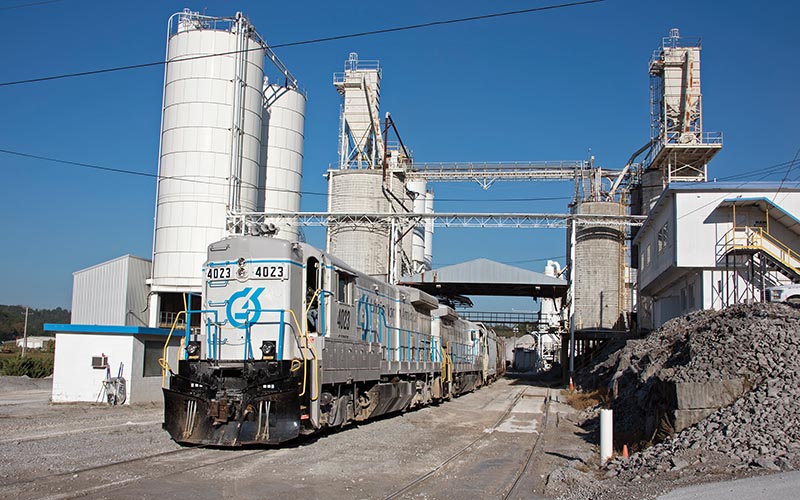 By Garland McKee/photos as noted
By Garland McKee/photos as noted
Sixteen miles of pure scenery. That’s Lhoist North America’s line between Crab Orchard and Rockwood, Tenn. The line was built by the Tennessee Central Railway and its predecessors in the 1880s and 1890s as part of the line connecting Nashville with the Southern Railway at Emory Gap. Eventually, the line would be part of the 286-mile route between Harriman and Hopkinsville, Ky.
Alas, the Tennessee Central was never very profitable, going in and out of receivership throughout its troubled history. The end finally came in 1968. Regional railroads were a dying breed, and no one wanted to save the poor old Tennessee Central. The railroad was divided up among the connecting railroads, with the eastern 36 miles between Harriman and Crossville going to the Southern Railway.
Southern eventually cut the line back to Crab Orchard in the 1990s, abandoning the 11 miles between there and Crossville. By 2001, Southern successor Norfolk Southern wanted out of the line to Crab Orchard too. The last remaining customer west of Rockwood was Franklin Industries, operator of Franklin Industrial Minerals, which operated a large limestone facility at Crab Orchard. The railroad was vital to Franklin Industrial Minerals, the largest producer of high-calcium chemical limestone in the U.S., so Franklin stepped up and purchased the 16 miles of trackage between Crab Orchard and Rockwood.

The return trip to Crab Orchard crosses the low curved trestle over Coalbank Hollow on September 17, 2017. As the name suggests, there was once a significant deposit of coal in the hills behind the bridge. The open lot was once home to the Roane Iron Company, which had its own narrow gauge railway that passed underneath. Nikos Kavoori photo
Franklin Industrial Minerals operated the railroad as a private industrial railroad using FIMX reporting marks. Interchange with NS was, and is, made at Rockwood. For power, FIMX purchased three high-hood General Electric B23-7s from NS — 3999 for parts, and 4021 and 4023 for service. It also purchased a low-nose B23-7 from CSX, 3138. Rounding out the roster was GE 110-ton centercab 1297. The four operating units were painted in a very attractive gray-and-white with red trim scheme that worked well amidst the limestone dust.
In 2006, Franklin Industries was sold to Chemical Lime Company, based in Fort Worth, Texas, a unit of global chemical concern the Lhoist Group headquartered in Limelette, Belgium. Thus, Franklin Industrial Minerals became part of Lhoist North America of Tennessee. It would be several years, however, before railfans noticed the difference, as Lhoist continued to operate under the Franklin Industrial Minerals name; it was several years before the units traded in their red trim for blue and a name change in the summer of 2012. Interestingly, Lhoist still uses the FIMX reporting marks and name…
 Read the rest of this article in the July 2018 issue of Railfan & Railroad!
Read the rest of this article in the July 2018 issue of Railfan & Railroad!



